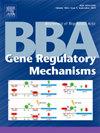缺氧诱导因子HIF1α在氯化钴诱导的缺氧过程中升高mRNA capping酶的表达。
IF 3.1
3区 生物学
Q3 BIOCHEMISTRY & MOLECULAR BIOLOGY
Biochimica et Biophysica Acta-Gene Regulatory Mechanisms
Pub Date : 2025-04-05
DOI:10.1016/j.bbagrm.2025.195087
引用次数: 0
摘要
低氧诱导因子(hif)通过调控转录组输出来缓解低氧胁迫。长链非编码rna (Long noncoding rna, lncRNA)在缺氧调控中起着至关重要的作用。与mRNA一样,lncRNAs受到细胞核中mRNA capping酶(CE)添加的5'帽的保护。由于认识到胞质盖顶酶(cCE)的存在,以前认为盖顶发生在细胞核内的观念发生了改变。研究表明,cCE可以重新封装存在于细胞质中的底物无帽mrna或长链非编码rna (lncRNAs),即使在亚砷酸盐诱导的氧化应激过程中也能阻止它们的降解。在本研究中,我们研究了CoCl2诱导的缺氧对cCE的影响及其在调节底物lncrna中的功能。在这里,我们通过染色质免疫沉淀和HIF1α抑制剂实验证明,CoCl2诱导的缺氧以依赖于HIF1α的方式提高细胞核和细胞质CE的表达。此外,我们发现cCE通过转录后调控其靶lncrna在CoCl2诱导的缺氧中的稳定性。这些结果表明,hif - 1α上调的cCE可能作为一些靶向cCE的lncrna的转录后调节剂。本文章由计算机程序翻译,如有差异,请以英文原文为准。

Hypoxia inducible factor HIF1α elevates expression of mRNA capping enzyme during cobalt chloride-induced hypoxia
In response to hypoxia, hypoxia-inducible factors (HIFs) control the transcriptomic output to mitigate the hypoxic stress. Long noncoding RNAs (lncRNA) are found to be very crucial in regulating hypoxia. Like mRNAs, lncRNAs are protected by 5′ caps that are added by mRNA capping enzyme (CE) in the nucleus. The previous concept that capping takes place in the nucleus was changed by the recognition of a cytoplasmic pool of capping enzyme (cCE). cCE has been shown to recap its substrate uncapped mRNAs or long noncoding RNAs (lncRNAs) present in the cytoplasm, preventing their degradation, even during arsenite-induced oxidative stress. In this study, we examined the effect of CoCl2 induced hypoxia on cCE and its function in regulating the substrate lncRNAs.
Here, we show that CoCl2 induced hypoxia elevates the expressions of nuclear and cytoplasmic CE in HIF1α dependent manner as evidenced by Chromatin immunoprecipitation and HIF1α inhibitor experiments. Furthermore, we found cCE post-transcriptionally controls the stability of its target lncRNAs amidst CoCl2 induced hypoxia. These results suggest that cCE, upregulated by HIF1α, may act as a posttranscriptional modulator for a few cCE-targeted lncRNAs.
求助全文
通过发布文献求助,成功后即可免费获取论文全文。
去求助
来源期刊
CiteScore
9.20
自引率
2.10%
发文量
63
审稿时长
44 days
期刊介绍:
BBA Gene Regulatory Mechanisms includes reports that describe novel insights into mechanisms of transcriptional, post-transcriptional and translational gene regulation. Special emphasis is placed on papers that identify epigenetic mechanisms of gene regulation, including chromatin, modification, and remodeling. This section also encompasses mechanistic studies of regulatory proteins and protein complexes; regulatory or mechanistic aspects of RNA processing; regulation of expression by small RNAs; genomic analysis of gene expression patterns; and modeling of gene regulatory pathways. Papers describing gene promoters, enhancers, silencers or other regulatory DNA regions must incorporate significant functions studies.

 求助内容:
求助内容: 应助结果提醒方式:
应助结果提醒方式:


